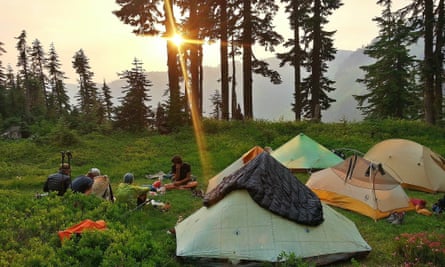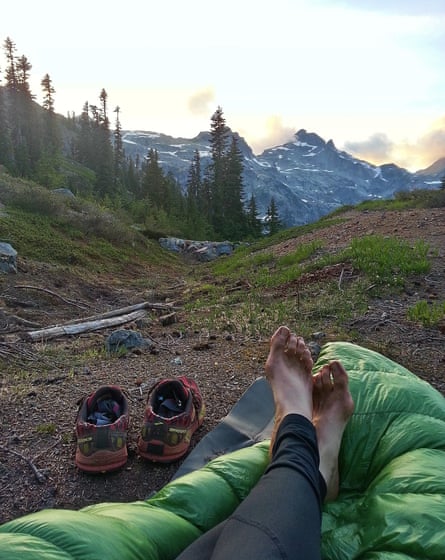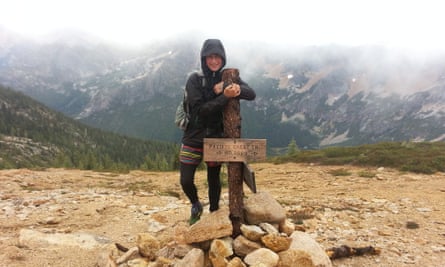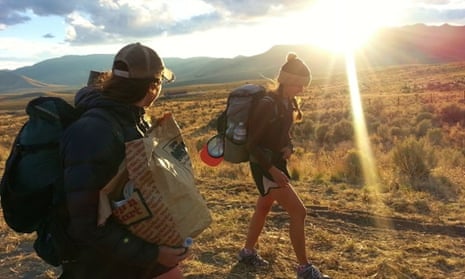Before I decided to walk from Mexico to Canada on the 2,660-mile Pacific Crest Trail, I had never done anything really physical in my life. I had never been an athlete, and I had never played sports. As a child I liked books, frolicking alone in the woods, and was terrified of anything involving a ball. As an adult I learned that exercise helped my anxiety, so I lackadaisically took up jogging, about two miles at a stretch.
The rest of the time I was, like most Americans, sedentary.
When I first discovered thru-hiking, I didn’t see it as an athletic endeavor so much as a Lord of the Rings-style adventure. Carrying my home on my back, walking across mountain ranges, making friends with other ragged characters on their own personal quests. Facing down storms, hunger, loneliness and whatever else might befall me. Emerging at the Canadian border bedraggled and changed. The hero’s journey.

Part of me knew that in order to make it to Canada before the snow flew, I would have to average 18 miles a day, which was more than I had ever hiked at once. But that detail seemed beside the point.
So I quit my life and set out into the desert, as one does. I carried few possessions. I gathered water from springs. I slept on the ground. I had no home. Except that I did – after a few weeks I realized that I was living, for the first time in my life, in my body.
My first month on the Pacific Crest Trail was painful. On day three I developed Achilles tendinitis, and had to learn how to deal with that: how to tape it, stretch it, how to hack the back part off my trail runners to give my Achilles tendons more room. There were people around, everywhere, to help me – other hikers with experience and knowledge.
I also had blisters: on the ball of my foot, on my heels, on my toes. Blisters developed inside of my blisters. I learned to drain the blisters when they appeared, tape them with athletic tape, remove the tape at night to let them dry out.
The desert was hot and stretches between water sources were sometimes long. I learned how much water I needed per mile in the heat, and how far I could push myself before I was in danger of heat exhaustion. I learned about my gait, and my pace – how to walk to put the least stress on my joints. I learned about hypothermia, muscle cramps, and how to tell when my electrolytes were off. I learned when I could push myself in the name of making miles, and when to lay off.
I learned all of these thing not because I wanted to be a jock, but because I wanted to reach Canada before winter.
And then one evening, sitting on the floor of the shower in my motel room in the town of Mojave, after fighting my way, alone, through hurricane-force winds for three days, I looked at my overly tanned, scratched-up calves, and realized that they were no longer made of flesh, but had turned to wood.

I was walking 25 miles a day, every day. I was pushing myself about 500 times harder, physically, than I ever had in my life. The entire rhythm of each day now revolved around my body: how much I could expect from it, and what it needed from me in return.
I had set out to walk from Mexico to Canada just for the sake of the adventure, and in the process I had become an athlete.
I’ve never thought of humans as being very physically strong, as far as the animal kingdom goes. We can’t sprint like a cheetah, climb like our primate friends, destroy stuff like a rhinoceros or even fly, which so many birds and insects have mastered. But there is one thing that we’re really, really good at.
Walking.
I am a regular human, not even particularly athletic, and I can walk 2,660 miles through the wilderness in five months. So can other humans, as demonstrated by the hundreds of people, many of them also not particularly athletic, who thru-hike the trail each year.
You know who cannot do this? Dogs. Also, horses. Aside from the rare exception, walking for 12 hours a day, day after day for months at a time, is too much for a dog or a horse. That’s just not how these animals – and many animals, for that matter – exercise. Dogs like to run around, wear themselves out, and then go to sleep. Sprinting and napping, sprinting and napping. That’s just how they do. Humans, on the other hand, are awake for 16 hours a day. And during this time we can walk slowly forward, endlessly. This long-distance walking is a weird talent, but it is one that is uniquely ours.
After that first month on the trail, the pain I was experiencing disappeared almost entirely. My body no longer ached at night. My blisters turned to thick calluses, protective coatings for my feet. My tendinitis was gone. Walking all day came to feel completely natural – more natural than sitting, to the point that on my days off I was stiff and sluggish, anxious to get back to it. All I wanted to do was hike. It was what my body now knew.
I had gone from a mostly sedentary world to one in which chairs didn’t even exist. And I felt fantastic.
There’s something else extraordinary about long-distance hiking. Something it shares with ultra-running, dog mushing and similar endurance activities.
Women are really good at it.
I didn’t know this when I set out to thru-hike for the first time, in 2013. I figured the men would be stronger, faster hikers, more likely to finish the trail, and that most women would be lucky to keep up. But that wasn’t the case; it turns out that thru-hiking is monumentally hard for almost everyone, and women are just as likely to excel at this tireless, long-distance endeavor as men.

On the trail I was passed by experienced female thru-hikers doing 40-mile days. Their packs were small, their shoes were battered and torn, and they were covered in dirt. They hiked alone or with others, walking from dawn until dusk, through storms and blazing heat and over high mountain passes, to collapse at night in hidden corners of the forest, cradled by the moss and tree roots.
They weren’t being dragged down the trail by their boyfriends. They weren’t complaining. They were out there because they loved it, and they were happy.
I was both stunned and inspired by these women. They seemed almost mythological.
My online research before starting the trail had framed the long-distance hiking community as a sort of boys’ club. Online hiking forums were populated by men, holding forth on this and that, and gear was made and sized for men, as though female long-distance hikers didn’t even exist. How was it that these badass hiker women were so good at what they did? And how could I be more like them?
That year, 2013, was also the year Heather “Anish” Anderson broke the overall self-supported speed record for the Pacific Crest Trail, a record that hadn’t changed hands in five years. She smashed the record by four days.
I never met Anish (she must have hiked by me in the night), but I followed her journey as best I could via her online updates, turning my phone on to check for service on ridgetops, trekking poles clutched in my other hand, heart racing, waiting to hear the news.
I was in Oregon when I learned that she had made it, that she had broken the record, finishing the 2,660-mile trail in just 60 days – and I started to cry while I was hiking. I remember walking through the lush Oregon forests near Mount Hood, blubbering and wiping snot from my face. Afterwards, I felt high for days.
Jess was another great hiker I met on the trail that year. Her first long walk was the 2,200-mile Appalachian Trail, which had hooked her on thru-hiking forever. During her 2013 thru-hike, Jess and a friend covered the Washington portion of the Pacific Crest Trail in just 15 days, averaging 33 miles a day. “It’s incredible that it’s possible to use my body to go such great distances,” she says when I ask her why she loves to hike. “And it’s a natural human rhythm that so few people get to experience.”
After finishing the Pacific Crest Trail in the cold rain in September 2013, my life, and the way I viewed what my body was capable of, was changed forever.
Right now, in the western world, our lives are mostly sedentary. But it doesn’t have to be this way. This moment in history is a very interesting time to be alive, and things are changing in ways we can’t yet fully comprehend. It’s up to us to determine what we want our reality to look like, how we want to move through the world in our physical bodies.
Walking across the continent for no reason other than the adventure and challenge of it may not be the answer for everyone. But for me, and for some other great women I’m lucky enough to call friends, it’s a start.

Comments (…)
Sign in or create your Guardian account to join the discussion